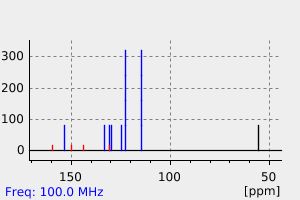4-methoxy-N-((E)-(2-nitrophenyl)methylidene)aniline
中文名称
——
中文别名
——
英文名称
4-methoxy-N-((E)-(2-nitrophenyl)methylidene)aniline
英文别名
2-nitro-N-benzylidene-4'-methoxyaniline;4-methoxyphenyl-2-nitrobenzylideneamine
CAS
——
化学式
C14H12N2O3
mdl
——
分子量
256.261
InChiKey
MOFALIQXICGDFI-XNTDXEJSSA-N
BEILSTEIN
——
EINECS
——
-
物化性质
-
计算性质
-
ADMET
-
安全信息
-
SDS
-
制备方法与用途
-
上下游信息
-
文献信息
-
表征谱图
-
同类化合物
-
相关功能分类
-
相关结构分类
计算性质
-
辛醇/水分配系数(LogP):3.35
-
重原子数:19.0
-
可旋转键数:4.0
-
环数:2.0
-
sp3杂化的碳原子比例:0.07
-
拓扑面积:64.73
-
氢给体数:0.0
-
氢受体数:4.0
反应信息
-
作为反应物:描述:4-methoxy-N-((E)-(2-nitrophenyl)methylidene)aniline 在 sodium tetrahydroborate 作用下, 以 甲醇 为溶剂, 以122 mg的产率得到4-methoxy-N-(2-nitrobenzyl)benzenamine参考文献:名称:使用新型整体式三苯基膦试剂进行有机叠氮化物的流式合成以及亚胺和胺的多步合成†摘要:在这里,我们描述了合成烷基和芳基叠氮化物的一般流程,以及新的整体式三苯基膦试剂的开发,这为在流动中使用这种多功能试剂提供了便利的形式。这些新工具的实用性已通过将其应用到Staudinger aza-Wittig流式反应序列中得到证明。最后,设计了多步的aza-Wittig,还原和纯化流程,允许以自动化方式访问胺产品。DOI:10.1039/c0ob00813c
-
作为产物:参考文献:名称:红外辐射:无溶剂形成 N-亚苄基苯胺的有效促进剂摘要:摘要 在无溶剂条件下,苯甲醛与苯胺的缩合反应中,红外辐射促进了一系列席夫碱的形成。对含有吸电子或放电子基团的苯甲醛和苯胺进行评估,以确定对席夫碱形成的任何取代基影响。该方法的特点是易于设置和处理,反应产率与之前报道的方法中获得的产率相当。此外,这种新程序对环境无害,因为在转化过程中没有使用溶剂。DOI:10.1081/scc-200026190
文献信息
-
Reductive heterocyclizations via indium–iodine-promoted conversion of 2-nitroaryl imines or 2-nitroarenes to 2,3-diaryl-substituted indazoles作者:Gil Hwan Ahn、Jung June Lee、Young Moo Jun、Byung Min Lee、Byeong Hyo KimDOI:10.1039/b707240f日期:——N-(2-nitrobenzylidene)anilines produced mixtures of 2,1-benzisoxazoles and 3-anilino-2-aryl-2H-indazoles in the presence of indium and iodine in MeOH, N-(2-nitrobenzylidene)anilines were transformed into 3-anilino-2-aryl-2H-indazoles as the predominant major product through the change of the solvent from protic MeOH to aprotic THF. In an indium-mediated one-pot reductive reaction, 2-benzaldehydes and anilines in THF
-
Reductive ring opening of 2-azetidinones promoted by sodium borohydride作者:Paola Del Buttero、Giorgio Molteni、Maurizio RoncoroniDOI:10.1016/j.tetlet.2006.01.103日期:2006.3Variously substituted 2-azetidinones 3 and 4 were reacted with sodium borohydride in aqueous isopropanol giving 3-aminopropan-1,2-dioles 5 and 7. Reaction extent was dependent upon the substitution pattern in the 3- and 4-positions of the 2-azetidinone ring and revealed good correlation with carbonyl LUMO energies of starting 3.
-
Novel Oxazabicycles as a New Class of Photochromic Colorants作者:Ding-Yah Yang、You-Sheng Chen、Pei-Yu Kuo、Jiun-Ting Lai、Chang-Ming Jiang、Chin-Hung Lai、Yong-Hong Liao、Pi-Tai ChouDOI:10.1021/ol702482c日期:2007.12.1A new photochromic colorant with an oxazabicyclic moiety has been synthesized by an efficient method. It turns pale red upon UV irradiation and undergoes reverse reaction while being heated. This work may open an exciting new avenue for future development of the photochromic dyes with novel molecular structures.
-
Asymmetric synthesis catalyst based on chiral brsnsted acid and method of asymmetric synthesis with the catalyst申请人:Akiyama Takahiko公开号:US20060276329A1公开(公告)日:2006-12-07A compound usable as an asymmetric synthesis catalyst which can be easily synthesized without using any metal such as a lanthanoid group element; a method of asymmetric synthesis with the compound; and a chiral compound obtained by the asymmetric synthesis method. A Broensted acid is used as a catalyst in asymmetric synthesis, the chiral Broensted acid being represented by formula (1) below or formula (3) below. The asymmetric synthesis method employs the catalyst. Asymmetric synthesis with the catalyst gives a chiral compound.
-
EP1623971申请人:——公开号:——公开(公告)日:——
表征谱图
-
氢谱1HNMR
-
质谱MS
-
碳谱13CNMR
-
红外IR
-
拉曼Raman
-
峰位数据
-
峰位匹配
-
表征信息
同类化合物
(βS)-β-氨基-4-(4-羟基苯氧基)-3,5-二碘苯甲丙醇
(S,S)-邻甲苯基-DIPAMP
(S)-(-)-7'-〔4(S)-(苄基)恶唑-2-基]-7-二(3,5-二-叔丁基苯基)膦基-2,2',3,3'-四氢-1,1-螺二氢茚
(S)-盐酸沙丁胺醇
(S)-3-(叔丁基)-4-(2,6-二甲氧基苯基)-2,3-二氢苯并[d][1,3]氧磷杂环戊二烯
(S)-2,2'-双[双(3,5-三氟甲基苯基)膦基]-4,4',6,6'-四甲氧基联苯
(S)-1-[3,5-双(三氟甲基)苯基]-3-[1-(二甲基氨基)-3-甲基丁烷-2-基]硫脲
(R)富马酸托特罗定
(R)-(-)-盐酸尼古地平
(R)-(-)-4,12-双(二苯基膦基)[2.2]对环芳烷(1,5环辛二烯)铑(I)四氟硼酸盐
(R)-(+)-7-双(3,5-二叔丁基苯基)膦基7''-[((6-甲基吡啶-2-基甲基)氨基]-2,2'',3,3''-四氢-1,1''-螺双茚满
(R)-(+)-7-双(3,5-二叔丁基苯基)膦基7''-[(4-叔丁基吡啶-2-基甲基)氨基]-2,2'',3,3''-四氢-1,1''-螺双茚满
(R)-(+)-7-双(3,5-二叔丁基苯基)膦基7''-[(3-甲基吡啶-2-基甲基)氨基]-2,2'',3,3''-四氢-1,1''-螺双茚满
(R)-(+)-4,7-双(3,5-二-叔丁基苯基)膦基-7“-[(吡啶-2-基甲基)氨基]-2,2”,3,3'-四氢1,1'-螺二茚满
(R)-3-(叔丁基)-4-(2,6-二苯氧基苯基)-2,3-二氢苯并[d][1,3]氧杂磷杂环戊烯
(R)-2-[((二苯基膦基)甲基]吡咯烷
(R)-1-[3,5-双(三氟甲基)苯基]-3-[1-(二甲基氨基)-3-甲基丁烷-2-基]硫脲
(N-(4-甲氧基苯基)-N-甲基-3-(1-哌啶基)丙-2-烯酰胺)
(5-溴-2-羟基苯基)-4-氯苯甲酮
(5-溴-2-氯苯基)(4-羟基苯基)甲酮
(5-氧代-3-苯基-2,5-二氢-1,2,3,4-oxatriazol-3-鎓)
(4S,5R)-4-甲基-5-苯基-1,2,3-氧代噻唑烷-2,2-二氧化物-3-羧酸叔丁酯
(4S,4''S)-2,2''-亚环戊基双[4,5-二氢-4-(苯甲基)恶唑]
(4-溴苯基)-[2-氟-4-[6-[甲基(丙-2-烯基)氨基]己氧基]苯基]甲酮
(4-丁氧基苯甲基)三苯基溴化磷
(3aR,8aR)-(-)-4,4,8,8-四(3,5-二甲基苯基)四氢-2,2-二甲基-6-苯基-1,3-二氧戊环[4,5-e]二恶唑磷
(3aR,6aS)-5-氧代六氢环戊基[c]吡咯-2(1H)-羧酸酯
(2Z)-3-[[(4-氯苯基)氨基]-2-氰基丙烯酸乙酯
(2S,3S,5S)-5-(叔丁氧基甲酰氨基)-2-(N-5-噻唑基-甲氧羰基)氨基-1,6-二苯基-3-羟基己烷
(2S,2''S,3S,3''S)-3,3''-二叔丁基-4,4''-双(2,6-二甲氧基苯基)-2,2'',3,3''-四氢-2,2''-联苯并[d][1,3]氧杂磷杂戊环
(2S)-(-)-2-{[[[[3,5-双(氟代甲基)苯基]氨基]硫代甲基]氨基}-N-(二苯基甲基)-N,3,3-三甲基丁酰胺
(2S)-2-[[[[[((1S,2S)-2-氨基环己基]氨基]硫代甲基]氨基]-N-(二苯甲基)-N,3,3-三甲基丁酰胺
(2S)-2-[[[[[[((1R,2R)-2-氨基环己基]氨基]硫代甲基]氨基]-N-(二苯甲基)-N,3,3-三甲基丁酰胺
(2-硝基苯基)磷酸三酰胺
(2,6-二氯苯基)乙酰氯
(2,3-二甲氧基-5-甲基苯基)硼酸
(1S,2S,3S,5S)-5-叠氮基-3-(苯基甲氧基)-2-[(苯基甲氧基)甲基]环戊醇
(1S,2S,3R,5R)-2-(苄氧基)甲基-6-氧杂双环[3.1.0]己-3-醇
(1-(4-氟苯基)环丙基)甲胺盐酸盐
(1-(3-溴苯基)环丁基)甲胺盐酸盐
(1-(2-氯苯基)环丁基)甲胺盐酸盐
(1-(2-氟苯基)环丙基)甲胺盐酸盐
(1-(2,6-二氟苯基)环丙基)甲胺盐酸盐
(-)-去甲基西布曲明
龙蒿油
龙胆酸钠
龙胆酸叔丁酯
龙胆酸
龙胆紫-d6
龙胆紫







